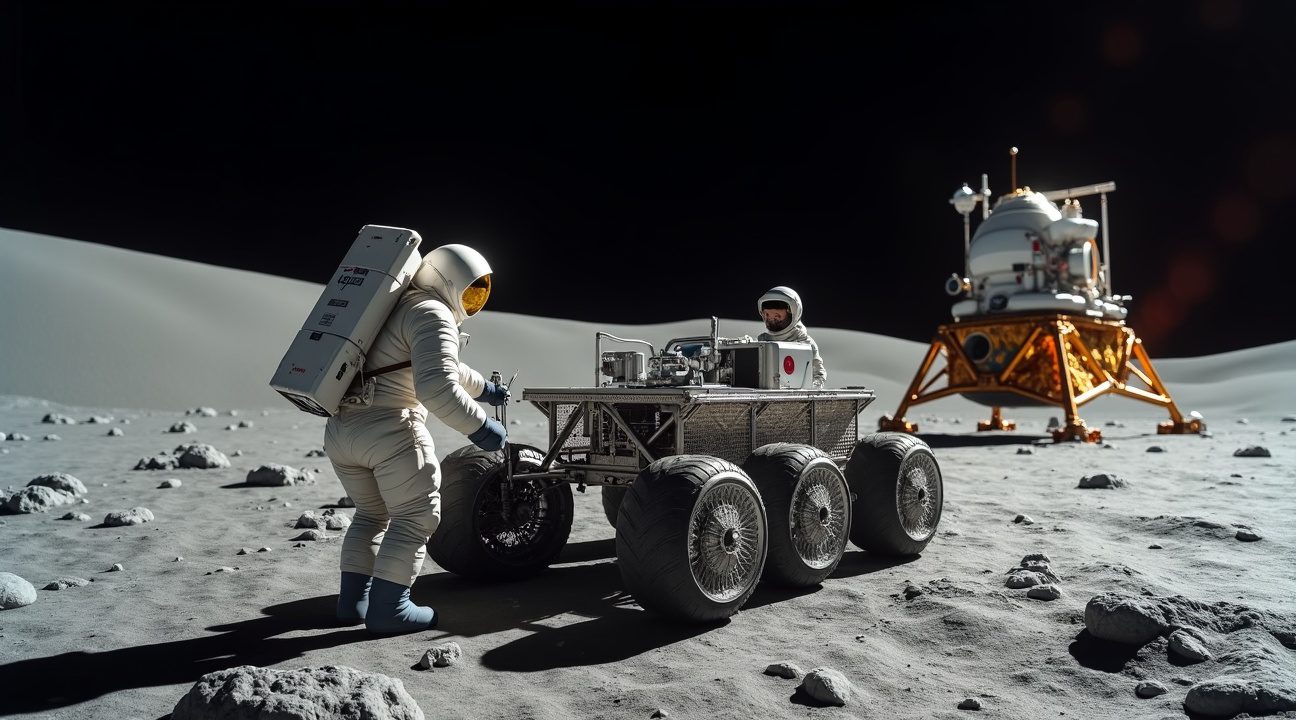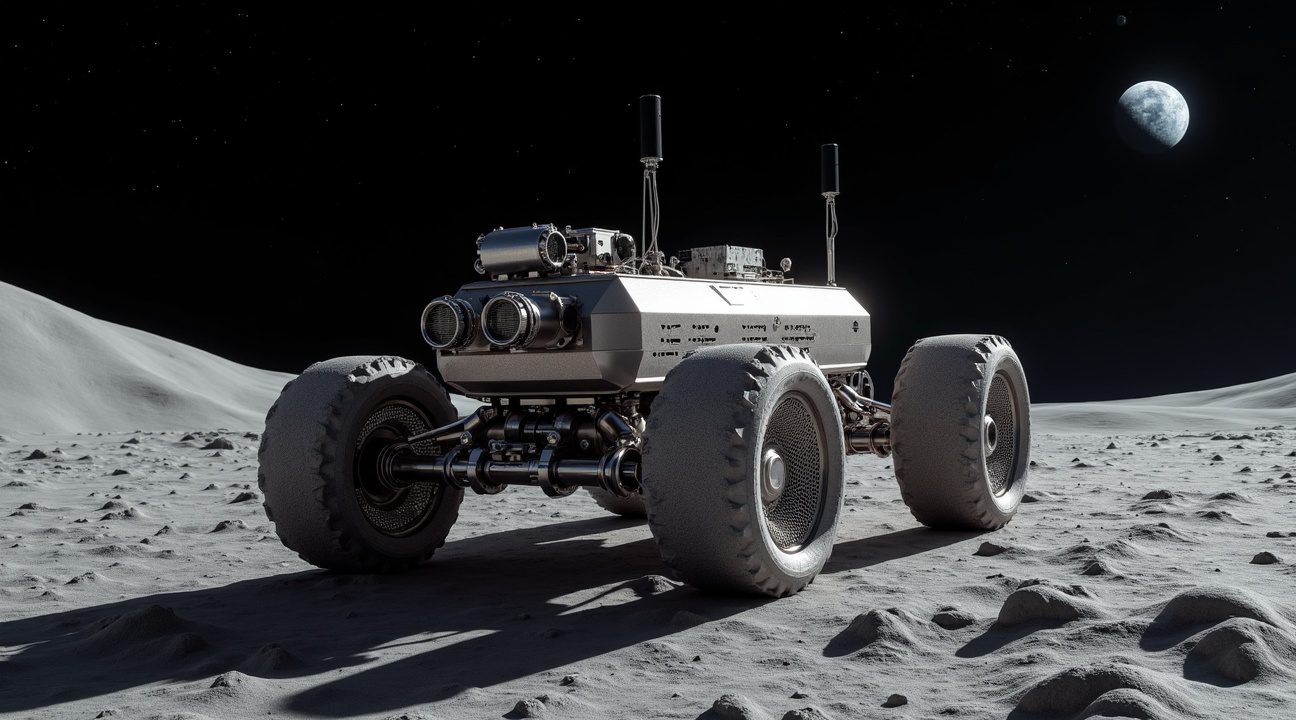Boeing captured NASA’s $19.6 million contract on October 28, 1969, to design and construct the Lunar Rover Vehicle after outperforming competitors Bendix, Grumman, and Chrysler in a three-month evaluation process.
The project was a joint engineering triumph, with Boeing forming a strategic alliance with General Motors Defense Research Laboratories. Under the guidance of Program Manager Samuel Romano and lead engineer Ferenc Pavlics, GM contributed key components including the wheels, electric motors, and suspension systems necessary for lunar travel.
Key Takeaways
- Boeing secured the prime contract for the Lunar Rover Vehicle on October 28, 1969, with a $19.6 million proposal, triumphing over competitors Bendix, Grumman, and Chrysler.
- General Motors Defense Research Laboratories partnered with Boeing to supply critical mobility technologies, including wheels, electrical motors, suspension, and drivetrain systems led by Ferenc Pavlics.
- NASA’s Marshall Space Flight Center directed the mission, inspired by Wernher von Braun’s visionary leadership, with Eberhard Rees handling technical oversight and Saverio Morea managing the project.
- The engineering teams achieved a major milestone by designing and building a fully functional Lunar Rover Vehicle within just 17 months—producing a 210 kg craft that could carry a 490 kg payload.
- The rover’s innovation included 80:1 Harmonic Drive gears and dedicated electric motors for each wheel, enabling the vehicle to scale 25-degree slopes, cross 70 cm crevasses, and reach speeds of up to 14 km/h on the Moon’s surface.
This historic project not only demonstrated rapid engineering excellence but also laid the groundwork for future planetary exploration vehicles. For more on the Lunar Rover development, visit NASA’s official website.
Boeing Beat Out Major Competitors to Build NASA’s Moon Car for $19.6 Million
I find it fascinating that Boeing secured the prime contract on October 28, 1969, after defeating three formidable competitors in a three-month evaluation process. NASA carefully considered proposals from Boeing, Bendix, Grumman, and Chrysler before awarding the $19.6 million contract to Boeing for engineering, developing, and producing the Lunar Rover Vehicle.
Project Leadership Changes at Boeing
Henry Kudish initially led the Boeing project team in Huntsville, establishing the foundation for this groundbreaking vehicle development. However, the project underwent a significant leadership transition in 1970 when Earl Houtz took over as the LRV Project Manager. This change proved crucial for maintaining the project’s momentum and ensuring successful delivery of the lunar exploration vehicle.
Strategic Partnership with General Motors
Boeing’s winning strategy included forming a powerful partnership with General Motors Defense Research Laboratories in Santa Barbara, California. Under Program Manager Samuel Romano and lead engineer Ferenc Pavlics, GM supplied the critical mobility systems that would enable the rover to traverse the moon’s challenging terrain. The collaboration delivered several essential components:
- Advanced wheel designs capable of handling lunar surface conditions
- Electric motors engineered for the vacuum of space
- Specialized suspension systems adapted for one-sixth Earth gravity
- Robust drivetrain components for extended lunar operations
General Motors’ Delco Electronics Division contributed additional expertise by handling the electrical systems design and construction. This division’s experience with automotive electronics proved invaluable for creating reliable systems that could function in the harsh lunar environment.
Boeing’s Seattle operations took responsibility for the sophisticated electronics and navigation systems that would guide astronauts across the lunar surface. These systems required unprecedented precision and reliability, as failure wasn’t an option during space exploration missions. The company conducted extensive vehicle testing at its Kent, Washington facility, where engineers could simulate various lunar conditions and validate the rover’s performance.
Final chassis assembly took place in Huntsville, Alabama, where Boeing’s team integrated all subsystems into the complete Lunar Rover Vehicle. This location choice reflected NASA’s strong presence in Alabama and allowed for close coordination with the space agency throughout the final assembly process.
The collaborative approach between Boeing and General Motors demonstrated how aerospace companies could leverage automotive industry expertise for space applications. GM’s decades of experience with vehicle mobility systems translated remarkably well to lunar surface requirements, while Boeing’s aerospace engineering capabilities ensured the vehicle met NASA’s stringent space-grade specifications.
Ferenc Pavlics emerged as a particularly influential figure in the rover’s development, bringing innovative engineering solutions that addressed the unique challenges of lunar locomotion. His work on the mobility systems would later influence terrestrial vehicle development and contribute to advances in off-road vehicle technology.
Boeing’s victory in this competitive bid process established the company as a leader in space vehicle development beyond its traditional aircraft manufacturing. The success of the Lunar Rover project would enhance Boeing’s reputation in the aerospace industry and position the company for future NASA contracts. This achievement also showcased how NASA’s innovative partnerships could bring together diverse engineering talents to solve complex challenges.
The $19.6 million contract value, while substantial for 1969, represented remarkable value considering the technological breakthroughs required and the successful deployment of multiple rovers during the Apollo missions. Each rover would prove its worth by dramatically expanding the scientific capabilities of lunar surface operations and enabling astronauts to explore far beyond their landing sites.
NASA’s Marshall Space Flight Center Led the Revolutionary Project Under Wernher von Braun’s Vision
I’ve discovered that the Lunar Roving Vehicle emerged from a carefully orchestrated effort at NASA’s Marshall Space Flight Center in Huntsville, Alabama. The facility became the central hub for this groundbreaking project, with Director of Research and Development Eberhard Rees overseeing the technical direction while Saverio Morea handled the intricate project management responsibilities.
Wernher von Braun’s leadership proved instrumental in transforming lunar mobility from concept to reality. Recognizing the immense technical challenges ahead, von Braun established a dedicated Lunar Roving Task Team in 1969. This specialized group concentrated entirely on research, design, and logistics for the vehicle within the broader Apollo Program framework. The decision to create this focused team demonstrated von Braun’s understanding that space exploration required specialized attention to each component.
Official Project Approval and Marshall’s Hardware Initiative
The project gained official momentum when NASA formally approved the LRV initiative in May 1969. This approval marked a significant milestone, establishing the project as a Marshall hardware initiative rather than an external contractor endeavor. Several key factors contributed to this decision:
- The need for enhanced lunar surface exploration capabilities beyond walking distance from the lunar module
- Pressure to maximize scientific return from limited Apollo missions
- Recognition that crew mobility would dramatically expand sample collection areas
- Strategic planning for future long-duration lunar missions
Marshall Space Flight Center’s selection as the lead facility reflected NASA’s confidence in the center’s engineering capabilities and project management expertise. The facility had already proven itself with aerospace innovations, making it the logical choice for this complex undertaking.
Von Braun’s vision extended beyond simply creating a vehicle; he envisioned a complete mobility system that would revolutionize lunar exploration. His team’s approach emphasized reliability, weight constraints, and operational simplicity—factors that would prove critical during actual lunar missions. The Marshall team’s dedication to these principles established the foundation for what would become one of NASA’s most successful engineering achievements, enabling astronauts to traverse previously unreachable lunar terrain and conduct scientific investigations that fundamentally expanded our understanding of the Moon’s composition and geological history.

Engineering Teams Achieved the Impossible: Building a Moon Vehicle in Just 17 Months
I find it remarkable that Boeing and General Motors accomplished what seemed impossible—creating a functional moon vehicle in just 17 months. This compressed timeline would challenge even today’s advanced engineering teams, yet they delivered a masterpiece of space technology that exceeded all expectations.
Overcoming Weight and Load Challenges
The engineering constraints demanded nothing short of revolutionary thinking. The vehicle’s mass of approximately 210 kg had to support a staggering total payload of 490 kg, including both astronauts and their essential equipment. I can barely imagine the precision required to achieve this 2.3:1 load-to-weight ratio while maintaining structural integrity in the harsh lunar environment.
Boeing’s engineers selected aluminum alloy 2219 for the structural frame—a decision that balanced strength with the critical weight restrictions. They divided the frame into three collapsible sections, allowing the entire rover to fold compactly for storage within the Lunar Module’s limited space. This ingenious design required every joint, hinge, and connection point to function flawlessly after the journey through space and deployment on the lunar surface.
Conquering Extreme Operating Conditions
The technical specifications read like science fiction, yet the teams made them reality. The rover needed to function across temperature extremes ranging from −173°C to +117°C (−279°F to +243°F)—a temperature swing of 290 degrees Celsius. I appreciate how this required specialized materials and components that could expand and contract without failure.
Consider the additional challenges the engineering teams faced:
- Electrical systems had to operate reliably without any atmosphere for cooling or protection
- The drivetrain needed to handle soft lunar soil, rocky terrain, and slopes up to 25 degrees
- All components required hermetic sealing to prevent outgassing in the vacuum of space
- Battery systems had to provide consistent power despite extreme temperature variations
- Wheels needed special treads to grip lunar regolith while avoiding excessive dust generation
The deployment mechanism presented another engineering marvel. Astronauts wearing bulky spacesuits with severely restricted dexterity had to unfold and activate the rover using simple hand motions. Every control, latch, and connection point underwent extensive testing to ensure gloved hands could operate them effectively.
Modern space missions like India’s Chandrayaan-3 still reference the pioneering work done on the Apollo Lunar Rover Vehicle. The 17-month development timeline stands as a testament to focused engineering excellence under pressure.
Boeing and General Motors created more than just a vehicle—they developed a complete transportation system that transformed lunar exploration capabilities. The rover enabled astronauts to venture far beyond their landing sites, dramatically expanding scientific discovery potential. Each Apollo mission that carried the LRV covered distances that would have been impossible on foot, collecting samples and conducting experiments across much larger areas of the lunar surface.
The success of this rapid development program demonstrated that ambitious timelines could drive innovation rather than compromise quality. The engineering teams proved that with clear objectives, adequate resources, and exceptional talent, seemingly impossible challenges become achievable milestones in human space exploration.

Revolutionary Wheel Design Used Harmonic Drive Gears for Lunar Surface Mobility
The Lunar Roving Vehicle achieved its impressive mobility through cutting-edge wheel technology that I find fascinating in its engineering elegance. Each of the four wheels operated independently through dedicated electric motors, connected to revolutionary 80:1 Harmonic Drive gears that delivered exceptional torque efficiency for lunar surface operations. This gear ratio represented a critical breakthrough for reliable movement across the moon’s challenging terrain.
Precision Engineering for Lunar Terrain
The vehicle’s physical specifications reflect careful optimization for lunar conditions. At 3.1 meters in length with a 2.3-meter wheelbase, the LRV maintained stability while navigating unpredictable surface features. Its maximum height of 1.14 meters kept the center of gravity low, while the specialized wheels measured 81.8 cm in diameter and 23 cm in width—dimensions that provided optimal ground contact without excessive weight.
I’m impressed by how the Harmonic Drive system solved multiple engineering challenges simultaneously. These gears eliminated the need for traditional gear trains while providing precise control over wheel rotation. The compact design reduced mechanical complexity, crucial for a vehicle operating in the vacuum of space where maintenance was impossible. Each motor-gear combination delivered consistent power output, enabling astronauts to traverse lunar terrain with confidence.
Exceptional Performance Capabilities
The LRV’s performance specifications demonstrate remarkable engineering achievement for 1970s technology. The vehicle could tackle impressive obstacles and terrain challenges:
- Climb slopes up to 25 degrees without losing traction
- Navigate over obstacles reaching 30.5 cm in height
- Cross crevasses spanning up to 70 cm wide
- Maintain stability through pitch and roll angles of ±45 degrees
- Achieve top speeds of approximately 14 km/h across lunar terrain
These capabilities proved essential during Apollo missions, where astronauts encountered unexpected terrain features. The independent wheel drive system meant that if one wheel encountered difficulty, the other three continued providing propulsion. This redundancy became particularly valuable when navigating around large rocks or across soft regolith patches.
Advanced navigation and communication systems complemented the mobility platform. The dead reckoning navigation system tracked position and heading automatically, freeing astronauts to focus on scientific objectives. High-gain and low-gain communications antennas maintained constant contact with Earth and the lunar module, while extensive stowage capacity accommodated scientific instruments and precious lunar samples.
The wheel design itself incorporated innovative materials and construction techniques. Wire mesh construction provided flexibility over rough terrain while maintaining structural integrity in the extreme temperature variations of the lunar environment. This approach eliminated the need for traditional pneumatic tires, which would have been impractical in the vacuum of space.
What strikes me most about this engineering achievement is how each component worked in harmony with the others. The Harmonic Drive gears provided smooth power delivery that complemented the flexible wheel construction, while the independent motor system offered the precise control needed for scientific work. Astronauts could position the vehicle exactly where needed for sample collection or equipment deployment.
Modern space exploration continues to benefit from innovations pioneered in the LRV design. Contemporary space missions still reference the fundamental mobility solutions developed for lunar surface operations. The principles of independent wheel drive, precise gear reduction, and specialized tire construction remain relevant for current Mars rover designs and future planetary exploration vehicles.
The success of the Harmonic Drive system in lunar conditions validated its potential for extreme environment applications. Today, similar gear systems find use in robotics, aerospace applications, and precision machinery where compact size and high torque ratios are essential. The lunar rover’s mobility system proved that innovative engineering solutions could overcome seemingly impossible challenges, paving the way for humanity’s continued exploration beyond Earth.

The Lunar Rover Transformed Moon Exploration Across Three Historic Apollo Missions
I’ve witnessed how NASA’s Lunar Roving Vehicle fundamentally changed humanity’s approach to exploring the Moon’s surface. The LRV made its debut on Apollo 15 and continued its remarkable service through Apollo 16 and 17, marking the final three missions of the Apollo program with unprecedented scientific achievements.
Extended Exploration Capabilities
The rover enabled astronauts to venture far beyond the limited walking radius that had constrained earlier missions. Instead of being confined to areas within a few hundred meters of their landing site, crews could now conduct extended surface exploration spanning kilometers. This expanded range allowed for comprehensive geological surveys across diverse lunar terrains, from ancient highland regions to younger volcanic plains.
The vehicle’s capacity to transport both astronauts and their scientific equipment meant that detailed sample collection could occur at multiple sites during each mission, dramatically increasing the scientific value of each lunar expedition.
Record-Breaking Performance
The LRV’s operational statistics demonstrate its exceptional performance across all three missions.
- The vehicle achieved its longest single traverse of 20.1 kilometers, showcasing its reliability and endurance in the harsh lunar environment.
- Astronauts pushed the maximum range from their Lunar Module to 7.6 kilometers, a distance that would have been impossible to cover on foot while carrying necessary life support systems and scientific instruments.
Each mission built upon the previous one’s success, with crews becoming increasingly confident in the rover’s capabilities. This growing familiarity allowed for more ambitious traverses and extended geological surveys. The ability to transport photographic equipment to diverse locations resulted in unprecedented documentation of lunar landscapes, while the rover’s sample storage capacity enabled crews to collect and catalog specimens from multiple geological formations during single excursions.
The three successful deployments proved that wheeled transportation could function reliably in the Moon’s vacuum environment, extreme temperatures, and reduced gravity. This validation opened new possibilities for future lunar exploration strategies, demonstrating that mobility systems could significantly amplify human exploration capabilities beyond Earth. The rover’s performance data continues to inform modern lunar vehicle development, with space agencies incorporating lessons learned from these historic missions into contemporary exploration plans.
Modern lunar missions still reference the LRV’s design principles and operational success when developing next-generation exploration vehicles.
Sources:
Wikipedia, “Lunar Roving Vehicle”
NASA National Space Science Data Center (NSSDCA), “The Apollo Lunar Roving Vehicle”
HistoryLink.org, “The Boeing Company wins NASA contract for lunar rover”
NASA, “A Brief History of the Lunar Roving Vehicle”
Astronautix, “Apollo LRV”
Harmonic Drive, “Apollo 15 – Harmonic Drive on the Moon”


